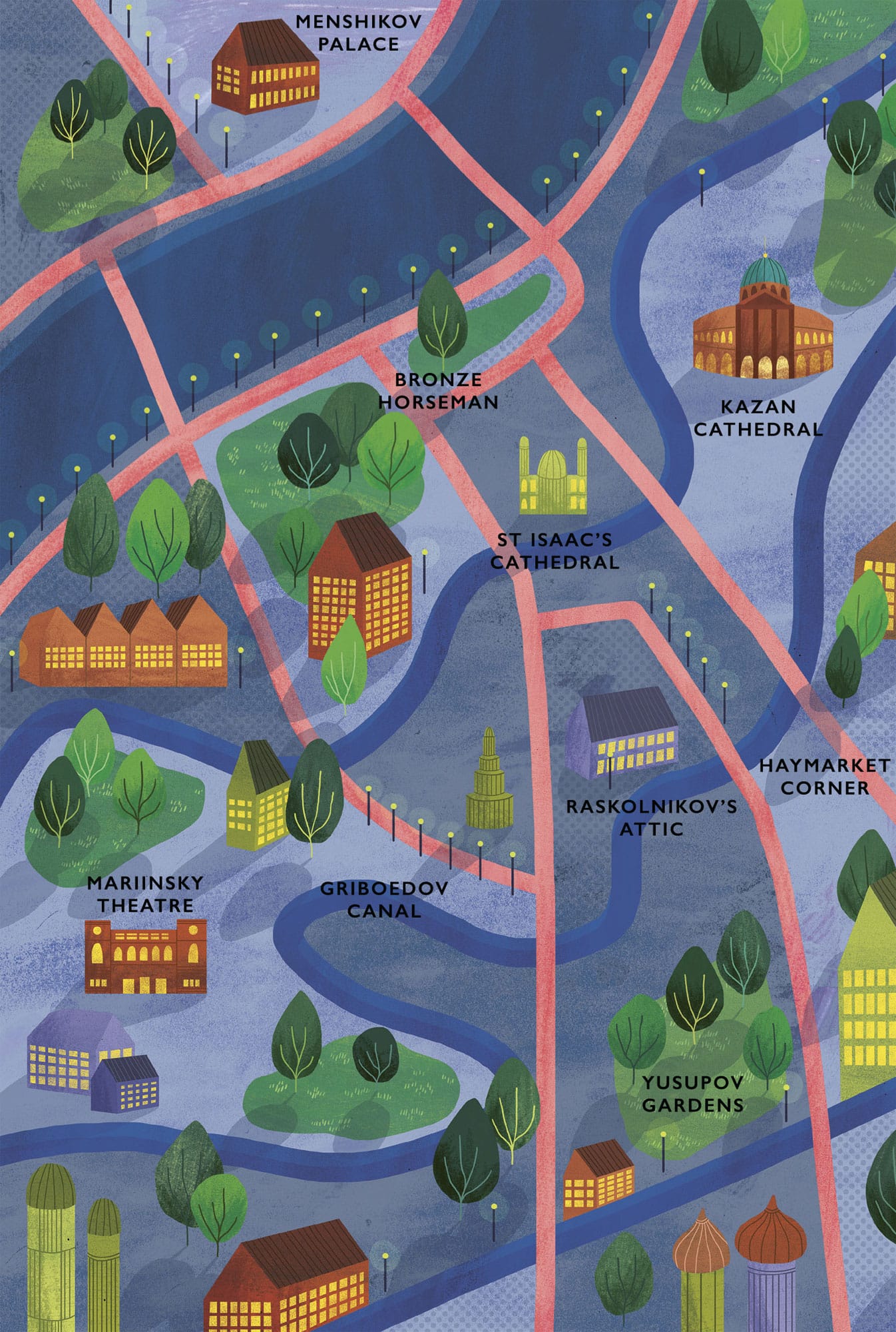ST PETERSBURG
Which? |
Crime and Punishment by Fyodor Dostoyevsky (1866) |
What? |
Imperial Russian city that can mess with a man’s soul |
THE CITY in July: humid, suffocating, penetratingly bright. The sun barely sets during these summer ‘white nights’; it glitters almost 24/7 on the canals, the baroque domes, the Neoclassical palaces and the Soviet tower blocks. It seems to swing like a spotlight, exposing everything. Or maybe that scrutiny is all in the mind – a hot-bothered brain, addled by issues of penury, morality, faith and murder …
Founded by Peter the Great in the early 18th century, St Petersburg was planned to be Russia’s ‘window on the West’. This modern capital, built on swampland by indentured labourers, grew quickly; by the 1860s it was overcrowded, and rife with poverty, crime and disease. This is the city of Fyodor Dostoyevsky. Like Dickens’ London, Dostoyevsky’s St Petersburg is desperate: there are, he writes, ‘few more grim, harsh and strange influences on a man’s soul than in Petersburg’.
Dostoyevsky’s Crime and Punishment, the world’s first psychological thriller, follows impoverished ex-student Rodion Raskolnikov who, in desperate need of money, devises a plan to rob and kill an unscrupulous old pawnbroker. Mental torment ensues. It’s a tale rooted in time and place. Not only does it exude the stink and suffocation of St Petersburg’s streets in July, circa 1866, it delves into the great philosophical debate dividing society at the time: should Russia embrace its place in Europe or return to its folk traditions? Dostoyevsky – conservative, religious, Slavophile – was of the latter school of thinking, and viewed rising Western ideas of nihilism, rational egoism and secularism as dangerous to the country’s future.


These are the ideas plaguing Raskolnikov, whose inner turmoil is mirrored in his external world. The novel shuns St Petersburg’s magnificence and instead roams its squalid back rooms, brothels and spit-sticky inns. The action is centred on Sennaya Ploshchad, the Haymarket district. In the 19th century it was a notorious slum area, cramped and chaotic. It’s been razed and cleaned up now, though one of the original buildings around the old market remains, the yellow Guardhouse – where Dostoyevsky himself spent two days imprisoned for a censorship violation in 1874.
Raskolnikov measures the footsteps – all 730 of them – between his rented attic and the home of the pawnbroker, and it’s possible to walk to the scene of the crime, just as he did. The antihero lived on the corner of Stolyarny and Grazhdansky streets; a plaque now marks the building, its words roughly translating as: ‘The tragic fates of the people of this area served as the basis of Dostoyevsky’s passionate sermon on good for all humankind.’
When finally fixed on robbing and killing the pawnbroker, Raskolnikov procures an axe and takes a roundabout route, heading slowly south along Stolyarny, which was then an alley of ‘unbearable stench’, heaving with dingy taverns and drunks. Dostoyevsky himself lived here, at the corner of Kaznacheisky Street, while writing Crime and Punishment.
Raskolnikov follows Stolyarny to Kokushkin Bridge – then wooden, now metal-railed – which spans the Griboedov Canal. Pre-revolution, this waterway through the heart of St Petersburg was officially known as Ekaterininsky, after Empress Catherine the Great. However, those who lived within sniffing distance called it kanava (ditch) – back then it was an open cesspit. These days it’s one of the city’s finest thoroughfares, cleaned up and flanked by resplendent buildings.
From the bridge, Raskolnikov walks via Yusupov Gardens, where he dreams of installing fountains to ‘refresh the air’; now it’s a public park where you can laze by the lake. After 20 minutes, he arrives at the pawnbroker’s apartment. It’s thought to be 104 Griboedov Canal, an apartment block with exits onto both the canal and a side street – perfect for an escaping felon. You can’t see inside – it’s a private home. For a more intimate encounter with Dostoyevsky, pay a visit to 5/2 Kuznechny Alley, the house where he died, and which is now a museum. Or head out to Alexander Nevsky Monastery to pay your respects at Dostoyevsky’s tomb.
